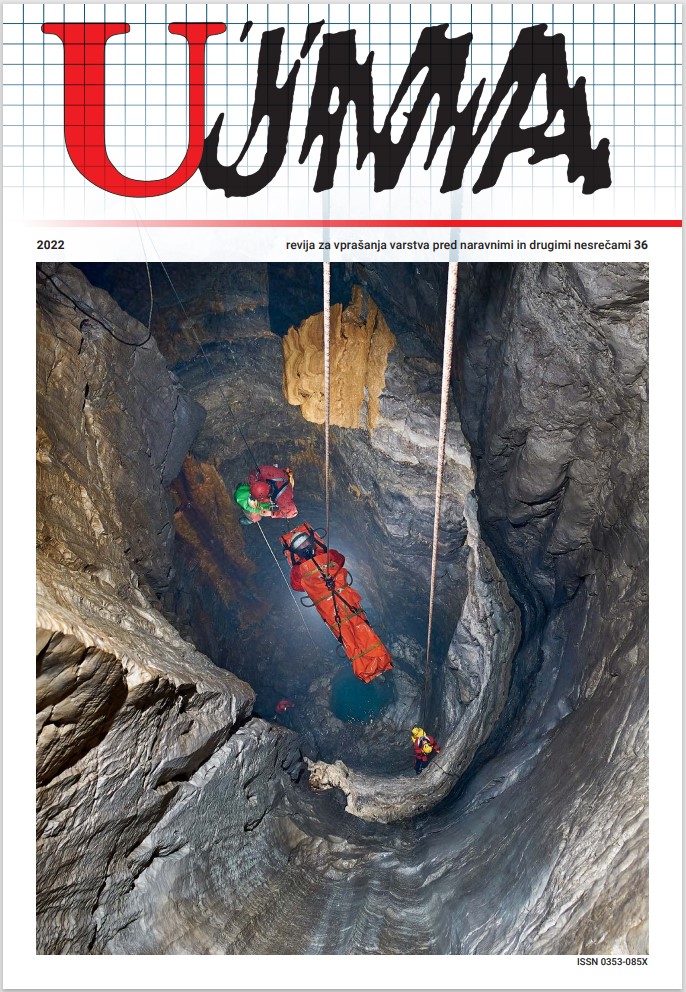EARTHQUAKE SURFACE FAULT RUPTURES AND THEIR INVESTIGATIONS
Abstract
Surface fault ruptures occur during very strong earthquakes with rather shallow hypocentres. They are primary earthquake effects, because they are the surface manifestation of the slip of two tectonic blocks, which for most earthquakes occur only at depth. They are characteristic of areas of the world with large tectonic deformations, such as Turkey, California, Taiwan and New Zealand. The largest fault ruptures are several tens of kilometres long with displacements of up to several metres, and can severely damage buildings, roads, railways and embankments. For critical infrastructure such as nuclear power plants, water dams and oil pipelines, the damage or collapse of which would produce catastrophic secondary effects, it is mandatory to demonstrate, through extensive investigations, that the danger of surface rupture is negligible. Surface ruptures are studied by geological, geomorphological, geodetic and geophysical methods. Among them, remote sensing methods, such as satellite radar interferometry and airborne laser scanning methods, have made the greatest progress in the past few decades. In Slovenia no earthquake surface rupture associated with a documented earthquake has yet been proven, although it has very likely occurred in the largest historical earthquakes. For this reason all necessary investigations are being carried out for critical infrastructure. Near Slovenia, an earthquake occurred in Petrinja (Croatia) in December 2020 with surface rupture displacements of up to 0.5 m.
References
Baize, S., Nurminen, F., Sarmiento, A., in sod., 2019. A Worldwide and Unified Database of Surface Ruptures (SURE) for Fault Displacement Hazard Analyses. Seismological Research Letters, 91/1, 499–520. doi.org/10.1785/0220190144.
Baker, J. W., Bradeley, B. A., Stafford, P. J., 2021. Seismic Hazard and Risk Analysis. Cambridge University Press, 581.
Dalguer, L. A., Day, S. M., Atkinson, G. M., Chen, R., 2021. Introduction to the Special Section on Fault Displacement and Near‐Source Ground‐Motion Models. Bulletin of the Seismological Society of America, 111/5, 2271–2274. doi.org/10.1785/0120210204.
Dasović, I., Herak, D., Herak, M., Stipčević, J., 2021. Niz potresa na Baniji. Vijesti Hrvatskoga geološkog društva, 57/2, 4-7.
European-Mediterranean Seismological Centre (EMSC), 2021. M6.4 Croatia on December 29th 2020 at 11:19 UTC, Special report, https://www.emsc-csem.org/Earthquake/264/M6-4-CROATIA-onDecember-29th-2020-at-11-19-UTC, 21. 3. 2022.
Fuis, G. S., Wald, L. A., 2003. Rupture in South-Central Alaska – The Denali Fault Earthquake of 2002. USGS Fact Sheet 014-03, 4 str.
Ganas, A., Elias, P., Valkaniotis, S., Tsironi, V., Karasante, I., Briole, P., 2021. Petrinja earthquake moved crust 10 feet, Temblor, 1-14, doi.org/10.32858/temblor.156.
Godec, M., Vidrih, R., Sinčič, P., 2003. Opazovanje seizmičnosti na območju velikih pregrad. Ujma 17–18, 208–2017.
Gosar, A., 1998. Seismic-reflection surveys of the Krško basin structure: Implications for earthquake hazard at the Krško nuclear power plant, southeast Slovenia. Journal of Applied Geophysics, 39/3, 131–153.
Gosar, 2003. Paleoseizmologija – izziv pri ocenjevanju potresne nevarnosti v Sloveniji. Ujma 17–18, 257–264.
Gosar, A., 2007. Letalsko lasersko skeniranje (LiDAR) Idrijskega in Ravenskega preloma v zahodni Sloveniji. Ujma 21, 139–144.
Gosar, A., 2012a. Application of Environmental Seismic Intensity scale (ESI 2007) to Krn Mountains 1998 Mw = 5.6 earthquake (NW Slovenia) with emphasis on rockfalls. Nat. hazards earth syst. sci., 12/5, 1659–1670.
Gosar, A., 2012b. Veliki Tohokski potres na Japonskem 11. marca 2011. Ujma 26, 86–91.
Gosar, A., 2014. Ocena intenzitet potresa leta 1998 v Krnskem pogorju z uporabo Environmental Seismic Intensity scale (ESI 2007). V: Zorn in sod. (ur.): (Ne)prilagojeni. Naravne nesreče 3. GIAM ZRC SAZU, 83–93.
Gosar, A., 2020. Measurements of tectonic micro-displacements within the Idrija fault zone in the Učja valley (W Slovenia). Acta geographica Slovenica, 60–1, 79–93.
Guerrieri, L., Vittori, E., 2007. Intensity Scale ESI 2007. Memorie Descrittive della Carta Geologica D‘Italia, 74, 41 str.
Jonsson, S., Zebker, H., Segall, P., Amelung, F., 2002. Fault Slip Distribution of the 1999 Mw 7.1 Hector Mine, California, Earthquake, Estimated from Satellite Radar and GPS Measurements. Bulletin of the Seismological Society of America. 92/4, 1377–1389. doi.org/10.1785/0120000922.
Nurminen, F., Boncio, P., Visini, F., Pace, B., Valentini, A., Baize, S., Scotti, O., 2020. Probability of Occurrence and Displacement Regression of Distributed Surface Rupturing for Reverse Earthquakes. Frontiers Earth Sciences, 8:581605. doi.org/10.3389/feart.2020.581605.
McCalpin, J., 2009. Paleoseismology. Academic Pres, 613 str. 20. Moores, E. M., Twiss, R. J., 1995. Tectonics. Freeman and Company, 414 str.
Oštir, K., 2006. Daljinsko zaznavanje. Založba ZRC SAZU, 250 str.
Tondi, E., Blumetti, A. M., Čičak, M., in sod., 2021. Conjugate coseismic surface faulting related with the 29 December 2020, Mw 6.4, Petrinja earthquake (Sisak-Moslavina, Croatia). Scientific Reports 11, 9150. doi.org/10.1038/s41598-021-88378-2.
Valentini, A., Fukushima, Y., Contri, P., in sod., 2021. Probabilistic Fault Displacement Hazard Assessment (PFDHA) for Nuclear Installations According to IAEA Safety Standards. Bulletin of the Seismological Society of America, 111/5, 2661–2672. doi.org/10.1785/0120210083.
Vidrih, R., Godec, M., 2000. Potres 20. septembra na Tajvanu. Ujma 14–15, 202–208.
Vukovski, M., 2021. Kratki osvrt na potrese u Banovini. Vijesti Hrvatskoga geološkog društva, 57/2, 8–15.
Wang, Z., Carpenter N. S., Zhang, L., Woolery E. W., 2017. Assessing Potential Ground-Motion Hazards from Induced Earthquake. Nat. Hazards Rev., 18/44, 04017018.
Wells, D. L., Coppersmith, K. J., 1994. New Empirical Relationship among Magnitude, Rupture lenght, Ruture area, and Surface displacement. Bulletin of Seismological Society of America, 84, 974–1002.
Wieland, M., Fan, B. H., 2004. The Activities of the International Commission on Large Dams (ICOLD) in the Earthquake Safety of Large Dams. 13th World Conference on Earthquake Engineering, Vancouver, 10 str.
Yeats, R. S., Sieh, K., Allen, C. R., 1997. The Geology of Earthquakes. Oxford University Press, 568 str.
Science Learning Hub, 2018. The Kaikoura earthquake and its consequences. https://www.sciencelearn.org.nz/events/408-the-kaikoura-earthquake-and-its-consequences, 2. 6. 2022.
Wikipedia. Surface rupture. https://en.wikipedia.org/wiki/Surface_rupture, 2. 6. 2022.
Wikipedia, 2016. Kaikoura earthquake. https://en.wikipedia.org/wiki/2016_Kaik%C5%8Dura_earthquake, 2. 6. 2022.
Downloads
Published
Issue
Section
License

This work is licensed under a Creative Commons Attribution-NonCommercial-NoDerivatives 4.0 International License.
The articles are made available to the public under Creative Commons Attribution-NonCommercial-NoDerivatives 4.0 International (CC BY-NC-ND 4.0).


